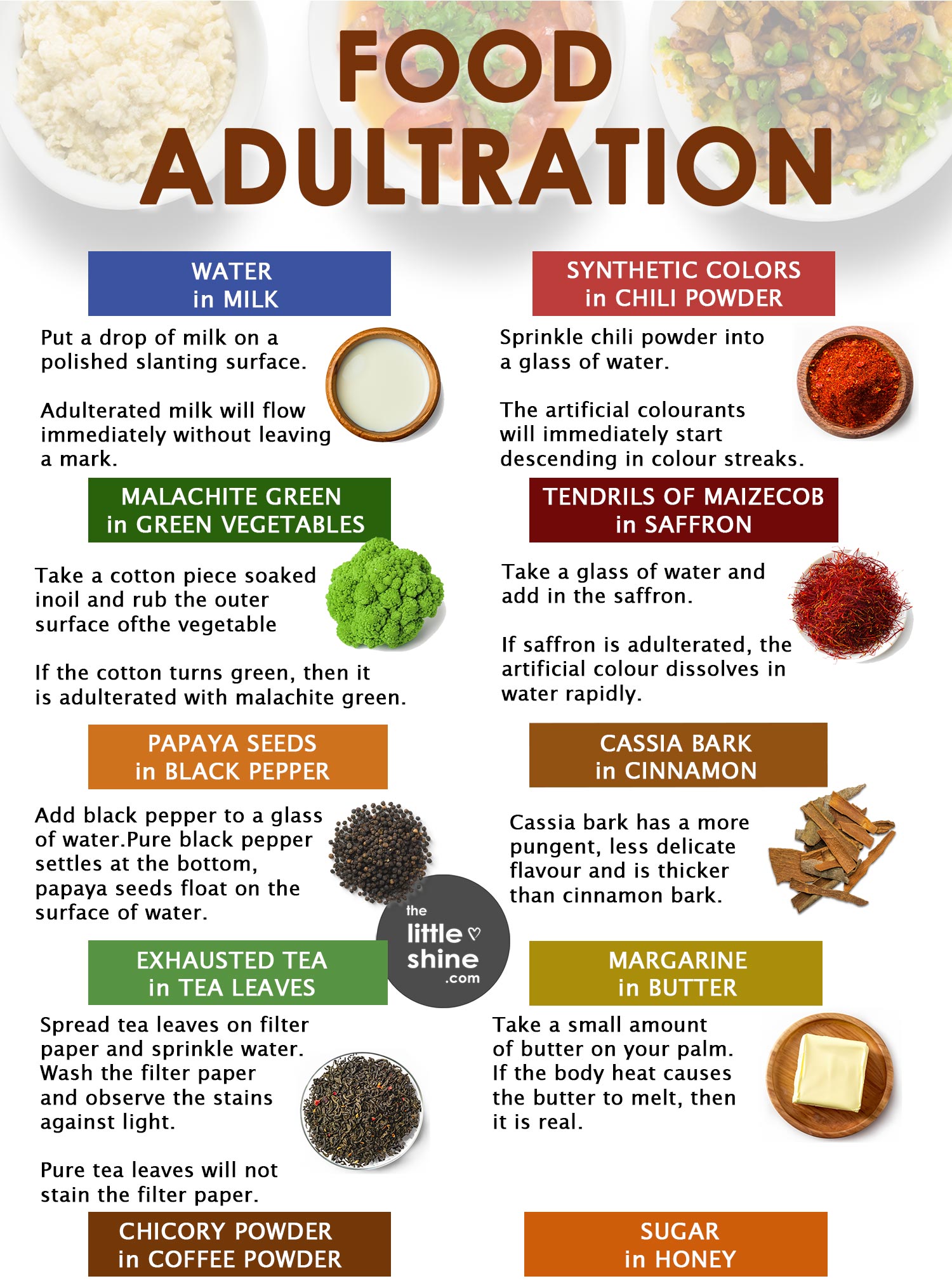Food adulteration is a rather common happening in the present day. From adding water into milk, margarine into butter, sugar syrup into honey etc. So how do we know that the food we’re eating is adulterated or not? How do we know what’s safe to consume?

Well, the best way is by doing a home detection test to get to know whether your product has been adultered or not.
In this article, we will talk about some of the most common adulterants in common food products/items and how to detect them the right way.
14 Common Food Items, Their Adulterants and How to Detect Them:
1. Milk
Adulterant: Water
Method of Detection: On a flat polished slanting surface, add a little milk and let it slide down. If it slides leaving behind a trail of white, it is not adultered. Adultered milk will not leave a white trail and will flow easily.
2. Butter
Adulterant: Margarine
Method of Detection: Place a small blob of butter on your palm for a few minutes. If it begins to melt with one’s body heat, then it is pure. Margarine will not melt and will remain as is.
3. Wheat Flour
Adulterant: Excess bran
Method of Detection: Into a glass of water, sprinkle some wheat flour. Excess bran will float on the surface.
4. Black Pepper
Adulterant: Dried papaya seeds
Method of Detection: You will be able to spot the difference between black pepper and papaya seeds, as the shape of the papaya seeds are oval and they are shrunken in size.
5. Turmeric Powder
Adulterant: Colored saw dust
Method of Detection: Into a glass of water, sprinkle some turmeric powder. Saw dust will float on the surface.
6. Cinnamon Sticks
Adulterant: Cassia bark
Method of Detection: Cinnamon sticks (made from cinnamon bark) roll well as it is thin and it has a tan-brown color, while cassia bark is thick and doesn’t roll well with a reddish brown color.
7. Iodized Salt
Adulterant: Common salt
Method of Detection: On a slice of potato, sprinkle some iodized salt. If the salt is adultered, the potato will get a slightly bluish tinge.
8. Saffron
Adulterant: Colored dried tendrils of maize cob
Method of Detection: Try to break a saffron strand; it will not break easily, whereas maize cob tendrils break easily. Alternatively, you can dissolve a few strands of saffron in water; the artificial color will dissolve easily.
9. Mustard Seeds
Adulterant: Argemone seeds
Method of Detection: Mustard seeds tend to have a smooth and flat surface, whereas argemone seeds have a rough surface.
10. Honey
Adulterant: Sugar syrup
Method of Detection: Into a glass of water, add in a tablespoon of honey. If it sinks to the bottom, as a lump (and doesn’t dissolve) then the honey isn’t adultered.
11. Ghee
Adulterant: Margarine
Method of Detection: Into a test tube, add in a tablespoon of ghee and heat it up. Then, add in a tablespoon of hydrochloric acid and shake well. If you see a pink shade appearing, the ghee has been adultered.
12. Coconut Oil
Adulterant: Mixed with other oils
Method of Detection: Place half a glass (or bottle) of coconut oil in the refrigerator. Coconut oil will solidify, leaving any adulterant separated.
12. Coffee
Adulterant: Chicory
Method of Detection: Gently sprinkle the coffee powder sample on the surface of water in a glass. The coffee floats over the water but chicory begins to sink down within a few seconds. The falling chicory powder particles leave behind them a trail of colour, due to large amount of caramel.
13. Tea Leaves
Adulterant: Exhausted tea
Method of Detection: Take a filter paper and spread some tea leaves. Sprinkle with water to wet the filter paper. If coal tar color is present it would immediately stain the filter paper. Wash the filter paper under tap water and observe the stains against light.
14. Cinnamon
Adulterant: Cassia bark
Method of Detection: Cinnamon barks are very thin and can be rolled. It can be rolled around a pencil or pen. It has a distinct smell. Whereas cassia bark comprise of several layers in between the rough outer and inner most smooth layers. Cassia bark has a more pungent, less delicate flavour and is thicker than cinnamon bark.